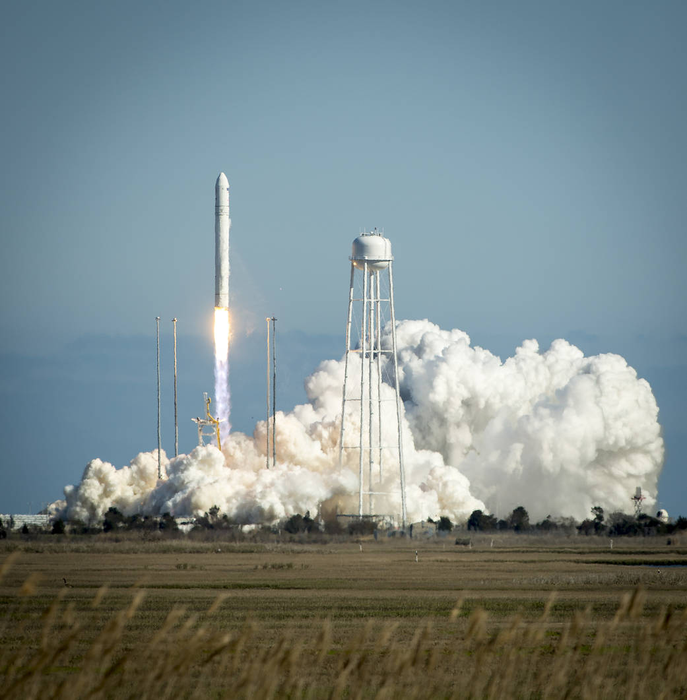A chemical used in electric vehicle batteries could also give us carbon-free fuel for space flight, according to new UC Riverside research.

Credit: NASA/Bill Ingalls
A chemical used in electric vehicle batteries could also give us carbon-free fuel for space flight, according to new UC Riverside research.
In addition to emission reductions, this chemical also has several advantages over other types of rocket fuels: higher energy, lower costs, and no requirement for frozen storage.
The chemical, ammonia borane, is currently used for storing the hydrogen in fuel cells that power electric vehicles. UCR researchers now understand how this combination of boron and hydrogen can release enough energy to also launch rockets and satellites.
“We are the first to demonstrate that in addition to electric vehicles, ammonia borane can be used to make rockets go too, under the right conditions,” said Prithwish Biswas, UCR chemical engineer and first author of the new study. Their demonstration has now been published in The Journal of Physical Chemistry C.
The most commonly used rocket fuels are hydrocarbon based and are known to have a variety of negative environmental impacts. They can poison the soil for decades, cause cancer, and produce acid rains, ozone holes and greenhouse gases like carbon dioxide.
By contrast, once burned, ammonia borane releases the benign compounds boron oxide and water. “It is much less harmful to the environment,” said Biswas.
Compared with hydrocarbon fuels, ammonia borane also releases more energy, potentially resulting in cost savings because less of it is required to power the same flight.
To release energy from the fuel and enable combustion, catalysts and oxidizers are added to supply extra oxygen to the fuel. Fuel cells often employ catalysts for this purpose. They enhance the rate of combustion, but they also stay in the same form both before and after the reaction.
“Spacecraft require high amounts of energy in a short amount of time, so it’s not ideal to use a catalyst because it doesn’t contribute to the energy you need. It’s like dead mass in your gas tank,” said Pankaj Ghildiyal, University of Maryland chemistry Ph.D. student and study co-author, currently working at UCR.
The inherent chemistry of ammonia borane decomposition hinders the release of its total energy on reaction with most oxidizers. However, the researchers found an oxidizer that alters the decomposition and oxidation mechanisms of this fuel, leading to the extraction of its total energy content.
“This is analogous to the use of catalytic converters to enable the complete combustion of hydrocarbon fuels,” Ghildiyal said. “Here, we were able to create more complete combustion of the chemicals and increase the energy of the entire reaction by using the chemistry of the oxidizer itself, without needing a catalyst.”
In addition to creating undesirable byproducts, some rocket fuels also require storage at sub-freezing temperatures. “NASA has used liquid hydrogen, which has very low density,” Ghildiyal said. “It therefore requires a lot of space as well as cryogenic conditions for maintenance.”
By contrast, this fuel is stable at room temperature and is resistant to high heat. In this study, the researchers created very fine, nanoscale particles of ammonium borane, which could degrade over the course of a month in very humid environments.
The research team is now studying the way ammonium borane particles of various sizes age in different environments. They’re also developing methods of encapsulating particles of the fuel a protective coating, to enhance their stability in moist conditions.
This research was supervised by Michael R. Zachariah, UCR chemical engineering professor, and funded by the U.S. Defense Threat Reduction Agency’s University Research Alliances program as well as the Office of Naval Research. The agencies granted the funds to help generate cleaner, more efficient flight fuels.
Quantum chemistry calculations required to support the experimental observations in this study were performed in collaboration with UCR material scientists Hyuna Kwon and Bryan M. Wong.
“We’ve determined the fundamental chemistry that powers this fuel and oxidizer combination,” Biswas said. “Now we are looking forward to seeing how it performs at large scale.”
Journal
The Journal of Physical Chemistry C
DOI
10.1021/acs.jpcc.1c08985
Article Title
Rerouting Pathways of Solid-State Ammonia Borane Energy Release
Article Publication Date
29-Dec-2021



